run flat HONDA CIVIC SEDAN 2014 Owner's Manual (in English)
[x] Cancel search | Manufacturer: HONDA, Model Year: 2014, Model line: CIVIC SEDAN, Model: HONDA CIVIC SEDAN 2014Pages: 469, PDF Size: 21.06 MB
Page 21 of 469
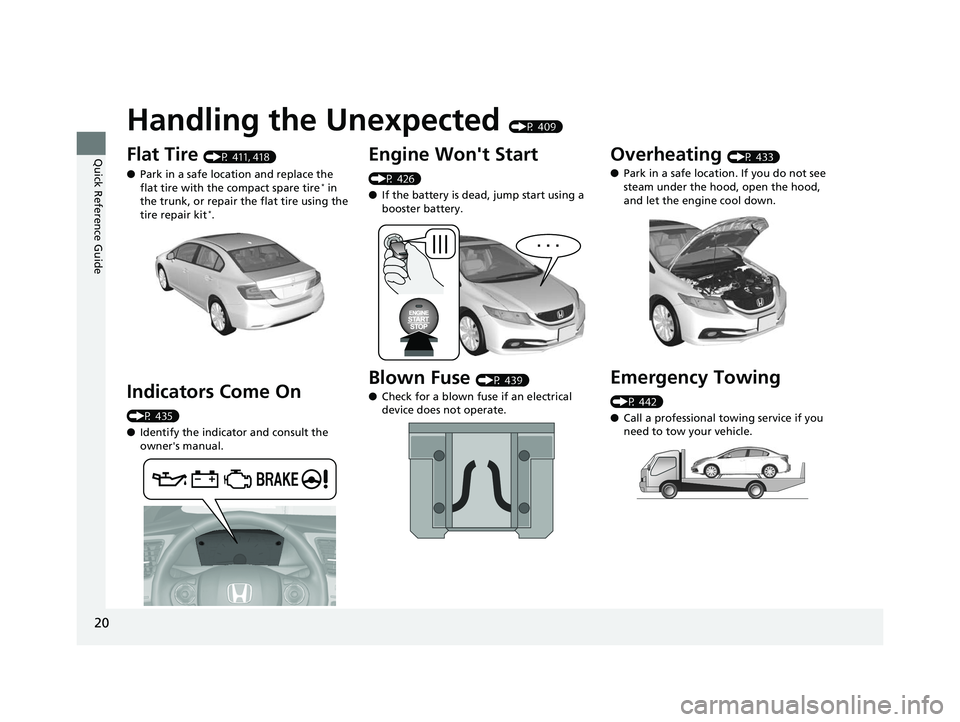
20
Quick Reference Guide
Handling the Unexpected (P 409)
Flat Tire (P 411, 418)
● Park in a safe location and replace the
flat tire with the compact spare tire
* in
the trunk, or repair the flat tire using the
tire repair kit
*.
Indicators Come On
(P 435)
● Identify the indicator and consult the
owner's manual.
Engine Won't Start
(P 426)
● If the battery is dead, jump start using a
booster battery.
Blown Fuse (P 439)
● Check for a blown fuse if an electrical
device does not operate.
Overheating (P 433)
● Park in a safe location. If you do not see
steam under the hood, open the hood,
and let the engine cool down.
Emergency Towing
(P 442)
●Call a professional towing service if you
need to tow your vehicle.
14 CIVIC 4D_SI-31TR36210.book 20 ページ 2014年1月30日 木曜日 午後12時18分
Page 74 of 469
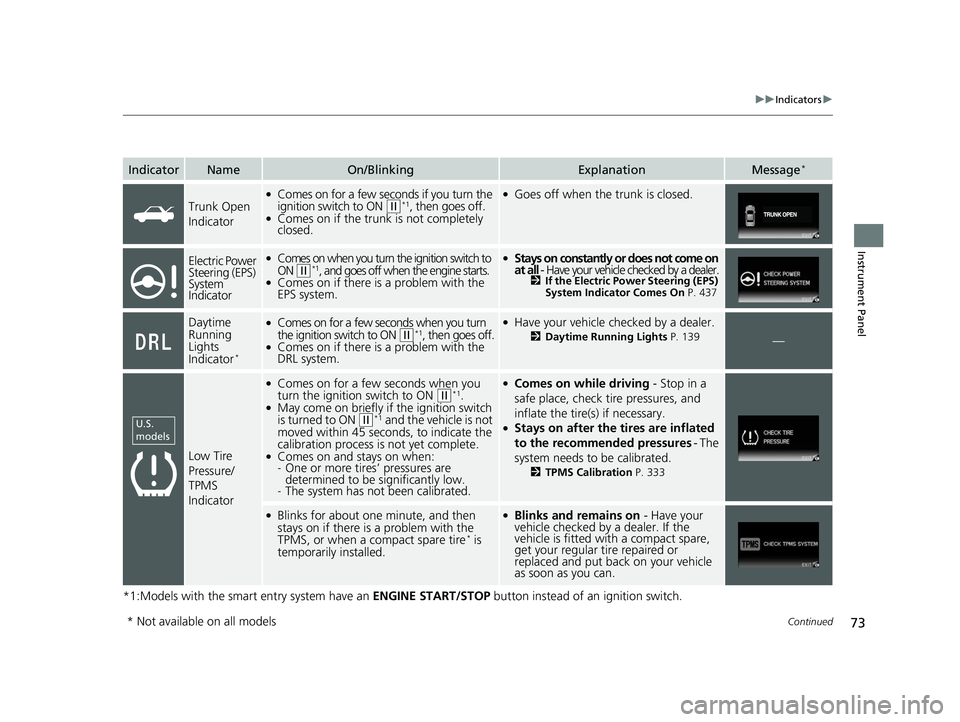
73
uuIndicators u
Continued
Instrument Panel
*1:Models with the smart entry system have an ENGINE START/STOP button instead of an ignition switch.
IndicatorNameOn/BlinkingExplanationMessage*
Trunk Open
Indicator
●Comes on for a few seconds if you turn the
ignition switch to ON (w*1, then goes off.●Comes on if the trunk is not completely
closed.
●Goes off when the trunk is closed.
Electric Power
Steering (EPS)
System
Indicator●Comes on when you turn the ignition switch to
ON (w*1, and goes off when the engine starts.●Comes on if there is a problem with the
EPS system.
●Stays on constantly or does not come on
at all - Have your vehicle checked by a dealer.
2If the Electric Power Steering (EPS)
System Indicator Comes On P. 437
Daytime
Running
Lights
Indicator
*
●Comes on for a few seconds when you turn
the ignition switch to ON (w*1, then goes off.●Comes on if there is a problem with the
DRL system.
●Have your vehicle checked by a dealer.
2Daytime Running Lights P. 139—
Low Tire
Pressure/
TPMS
Indicator
●Comes on for a few seconds when you
turn the ignition switch to ON (w*1.●May come on briefly if the ignition switch
is turned to ON (w*1 and the vehicle is not
moved within 45 second s, to indicate the
calibration process is not yet complete.
●Comes on and stays on when:
- One or more tires’ pressures are
determined to be significantly low.
- The system has not been calibrated.
●Comes on while driving - Stop in a
safe place, check tire pressures, and
inflate the tire(s) if necessary.
●Stays on after the tires are inflated
to the recommended pressures - The
system needs to be calibrated.
2 TPMS Calibration P. 333
●Blinks for about one minute, and then
stays on if there is a problem with the
TPMS, or when a compact spare tire
* is
temporarily installed.
●Blinks and remains on - Have your
vehicle checked by a dealer. If the
vehicle is fitted with a compact spare,
get your regular tire repaired or
replaced and put back on your vehicle
as soon as you can.
U.S.
models
* Not available on all models
14 CIVIC 4D_SI-31TR36210.book 73 ページ 2014年1月30日 木曜日 午後12時18分
Page 387 of 469
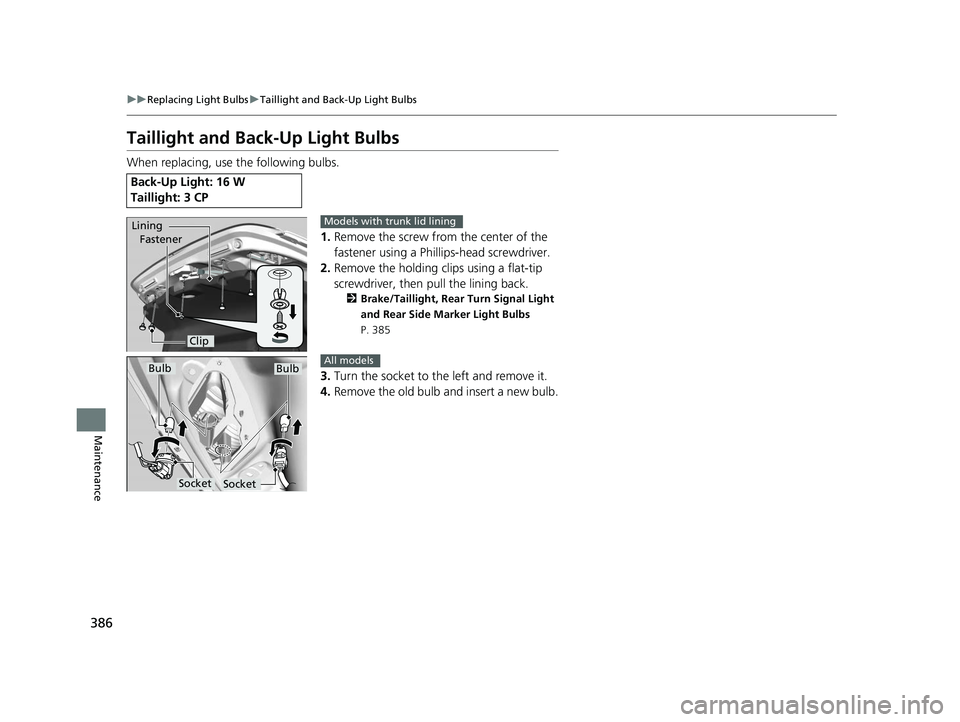
386
uuReplacing Light Bulbs uTaillight and Back-Up Light Bulbs
Maintenance
Taillight and Back-Up Light Bulbs
When replacing, use the following bulbs.
1.Remove the screw from the center of the
fastener using a Phillips-head screwdriver.
2. Remove the holding clips using a flat-tip
screwdriver, then pull the lining back.
2Brake/Taillight, Rear Turn Signal Light
and Rear Side Marker Light Bulbs
P. 385
3. Turn the socket to the left and remove it.
4. Remove the old bulb and insert a new bulb.
Back-Up Light: 16 W
Taillight: 3 CP
Lining
Fastener
Clip
Models with trunk lid lining
Bulb
Socket
Bulb
Socket
All models
14 CIVIC 4D_SI-31TR36210.book 386 ページ 2014年1月30日 木曜日 午後12時18分
Page 388 of 469
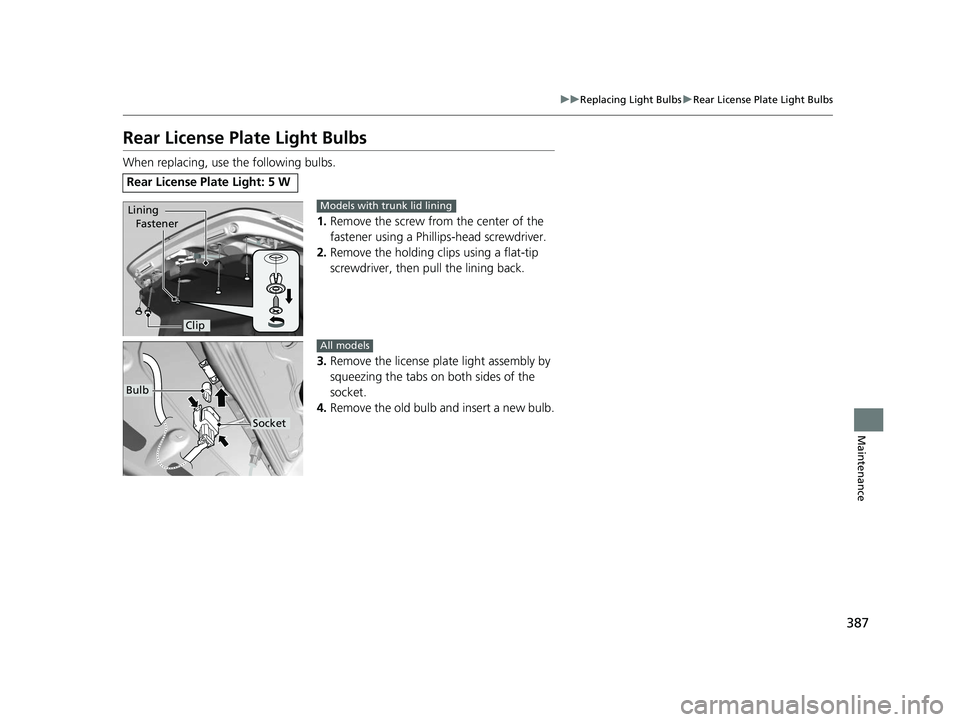
387
uuReplacing Light Bulbs uRear License Plate Light Bulbs
Maintenance
Rear License Plate Light Bulbs
When replacing, use the following bulbs.
1.Remove the screw from the center of the
fastener using a Phillips-head screwdriver.
2. Remove the holding cl ips using a flat-tip
screwdriver, then pull the lining back.
3. Remove the license plat e light assembly by
squeezing the tabs on both sides of the
socket.
4. Remove the old bulb and insert a new bulb.
Rear License Plate Light: 5 W
Lining
Fastener
Clip
Models with trunk lid lining
Bulb
Socket
All models
14 CIVIC 4D_SI-31TR36210.book 387 ページ 2014年1月30日 木曜日 午後12時18分
Page 413 of 469
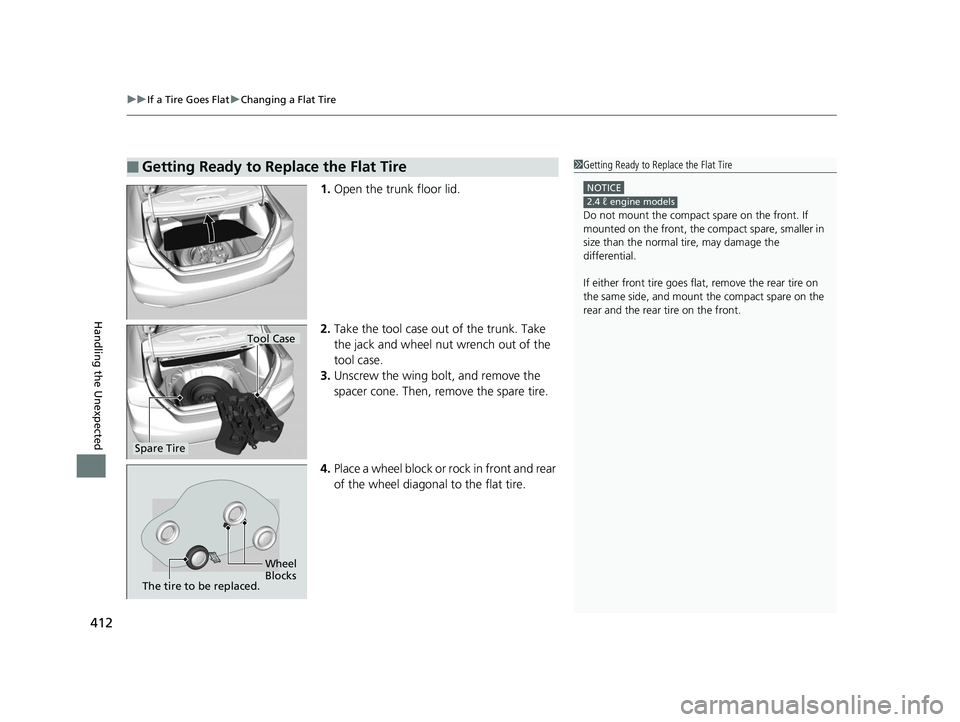
uuIf a Tire Goes Flat uChanging a Flat Tire
412
Handling the Unexpected
1. Open the trunk floor lid.
2. Take the tool case out of the trunk. Take
the jack and wheel nut wrench out of the
tool case.
3. Unscrew the wing bolt, and remove the
spacer cone. Then, remove the spare tire.
4. Place a wheel block or ro ck in front and rear
of the wheel diagonal to the flat tire.
■Getting Ready to Replace the Flat Tire1 Getting Ready to Replace the Flat Tire
NOTICE
Do not mount the compact spare on the front. If
mounted on the front, the compact spare, smaller in
size than the normal tire, may damage the
differential.
If either front tire goes flat, remove the rear tire on
the same side, and mount the compact spare on the
rear and the rear tire on the front.
2.4 ℓ engine models
Tool Case
Spare Tire
Wheel
Blocks
The tire to be replaced.
14 CIVIC 4D_SI-31TR36210.book 412 ページ 2014年1月30日 木曜日 午後12時18分
Page 415 of 469
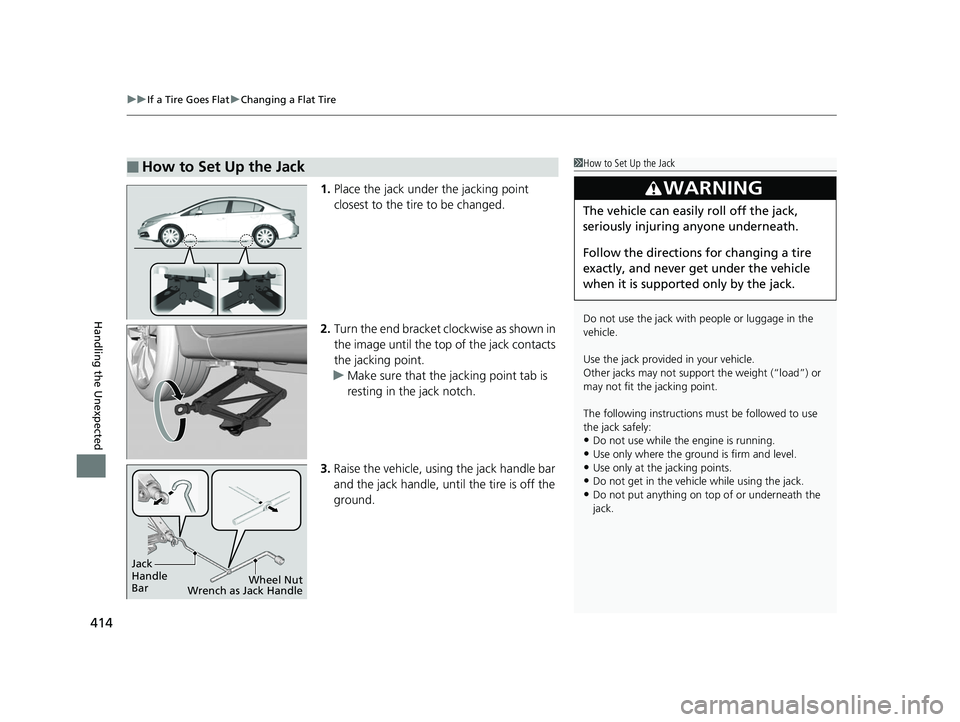
uuIf a Tire Goes Flat uChanging a Flat Tire
414
Handling the Unexpected
1. Place the jack under the jacking point
closest to the tire to be changed.
2. Turn the end bracket cl ockwise as shown in
the image until the top of the jack contacts
the jacking point.
u Make sure that the jacking point tab is
resting in the jack notch.
3. Raise the vehicle, using the jack handle bar
and the jack handle, until the tire is off the
ground.
■How to Set Up the Jack1How to Set Up the Jack
Do not use the jack with people or luggage in the
vehicle.
Use the jack provided in your vehicle.
Other jacks may not support the weight (“load”) or
may not fit the jacking point.
The following instructions must be followed to use
the jack safely:
•Do not use while the engine is running.
•Use only where the ground is firm and level.
•Use only at the jacking points.•Do not get in the vehicl e while using the jack.
•Do not put anything on top of or underneath the
jack.
3WARNING
The vehicle can easily roll off the jack,
seriously injuring anyone underneath.
Follow the directions for changing a tire
exactly, and never get under the vehicle
when it is supported only by the jack.
Jack
Handle
Bar Wheel Nut
Wrench as Jack Handle
14 CIVIC 4D_SI-31TR36210.book 414 ページ 2014年1月30日 木曜日 午後12時18分
Page 417 of 469
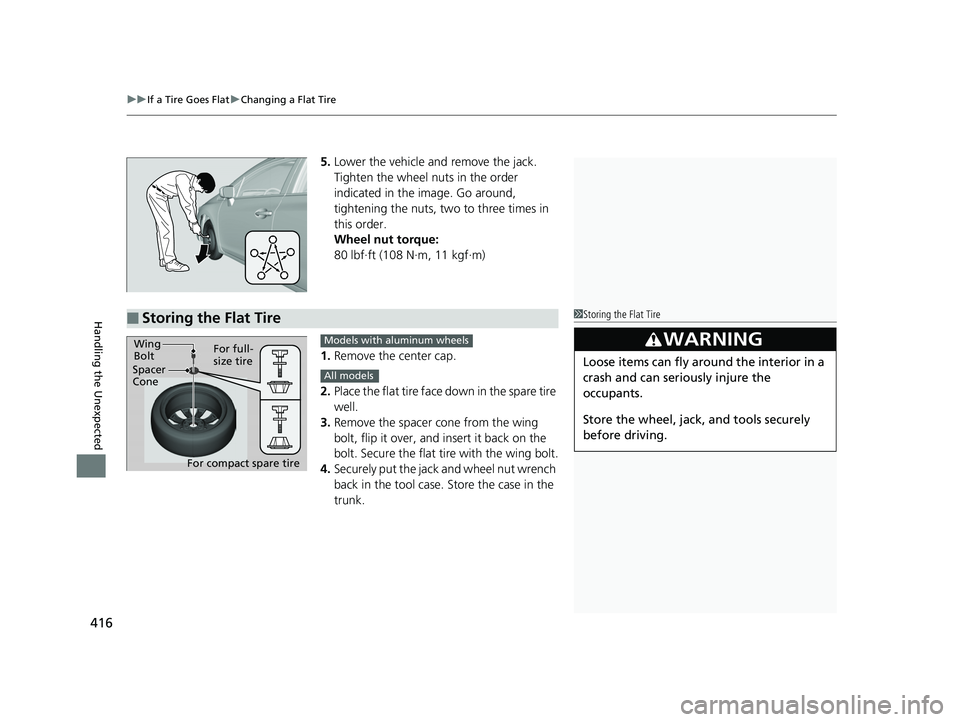
uuIf a Tire Goes Flat uChanging a Flat Tire
416
Handling the Unexpected
5. Lower the vehicle and remove the jack.
Tighten the wheel nuts in the order
indicated in the image. Go around,
tightening the nuts, two to three times in
this order.
Wheel nut torque:
80 lbf∙ft (108 N∙m, 11 kgf∙m)
1. Remove the center cap.
2. Place the flat tire face down in the spare tire
well.
3. Remove the spacer cone from the wing
bolt, flip it over, and insert it back on the
bolt. Secure the flat tire with the wing bolt.
4. Securely put the jack and wheel nut wrench
back in the tool case. Store the case in the
trunk.
■Storing the Flat Tire1Storing the Flat Tire
3WARNING
Loose items can fly around the interior in a
crash and can seriously injure the
occupants.
Store the wheel, jack, and tools securely
before driving.Spacer
ConeWing
Bolt
For compact spare tireFor full-
size tire
Models with aluminum wheels
All models
14 CIVIC 4D_SI-31TR36210.book 416 ページ 2014年1月30日 木曜日 午後12時18分
Page 420 of 469
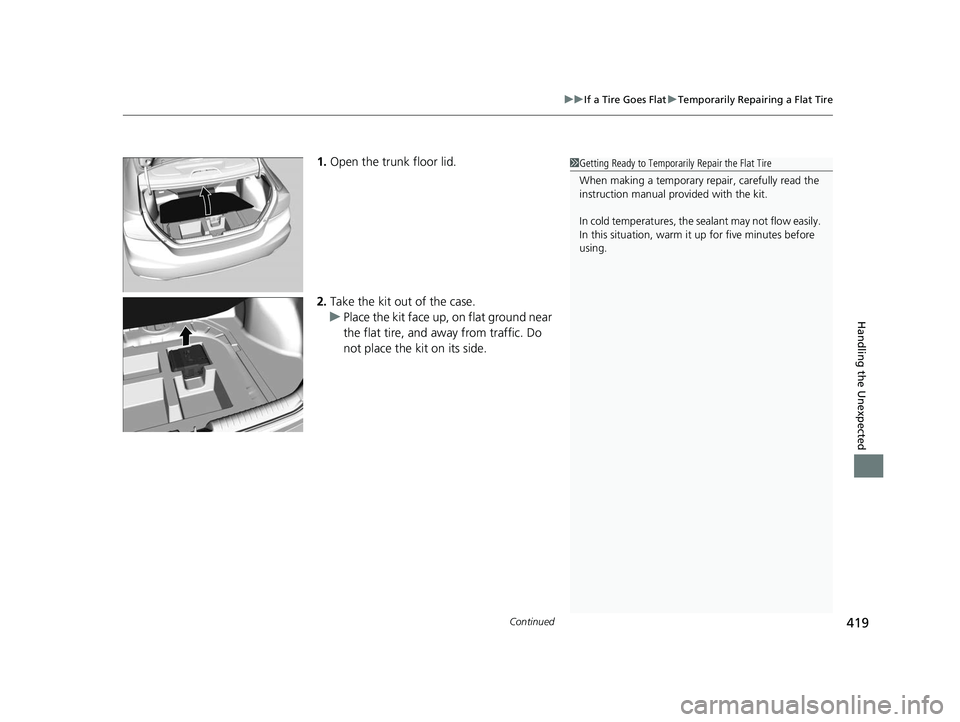
Continued419
uuIf a Tire Goes Flat uTemporarily Repairing a Flat Tire
Handling the Unexpected
1. Open the trunk floor lid.
2. Take the kit out of the case.
u Place the kit face up, on flat ground near
the flat tire, and away from traffic. Do
not place the kit on its side.1 Getting Ready to Temporarily Repair the Flat Tire
When making a temporary repair, carefully read the
instruction manual provided with the kit.
In cold temperatures, the sealant may not flow easily.
In this situation, warm it up for five minutes before
using.
14 CIVIC 4D_SI-31TR36210.book 419 ページ 2014年1月30日 木曜日 午後12時18分
Page 422 of 469
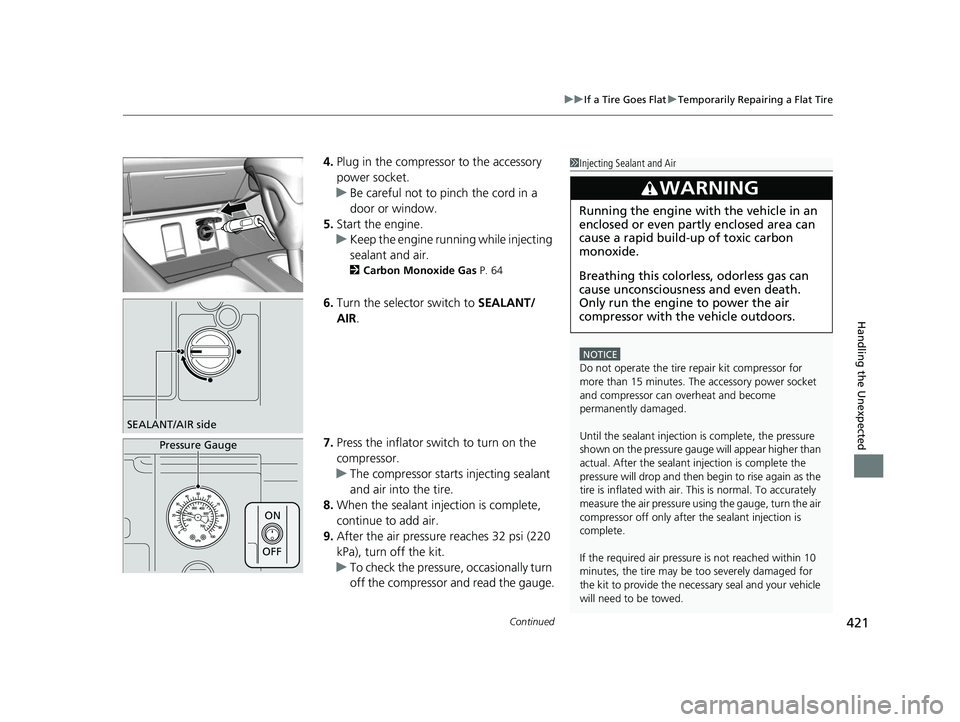
Continued421
uuIf a Tire Goes Flat uTemporarily Repairing a Flat Tire
Handling the Unexpected
4. Plug in the compressor to the accessory
power socket.
u Be careful not to pinch the cord in a
door or window.
5. Start the engine.
u Keep the engine running while injecting
sealant and air.
2 Carbon Monoxide Gas P. 64
6.Turn the selector switch to SEALANT/
AIR .
7. Press the inflator switch to turn on the
compressor.
u The compressor starts injecting sealant
and air into the tire.
8. When the sealant injection is complete,
continue to add air.
9. After the air pressure reaches 32 psi (220
kPa), turn off the kit.
u To check the pressure, occasionally turn
off the compressor and read the gauge.
1Injecting Sealant and Air
NOTICE
Do not operate the tire repair kit compressor for
more than 15 minutes. The accessory power socket
and compressor can ov erheat and become
permanently damaged.
Until the sealant injection is complete, the pressure
shown on the pressure gauge will appear higher than
actual. After the sealant injection is complete the
pressure will drop and then begin to rise again as the
tire is inflated with air. This is normal. To accurately
measure the air pressure usi ng the gauge, turn the air
compressor off only after the sealant injection is
complete.
If the required air pressure is not reached within 10
minutes, the tire may be too severely damaged for
the kit to provide the necessa ry seal and your vehicle
will need to be towed.
3WARNING
Running the engine with the vehicle in an
enclosed or even partly enclosed area can
cause a rapid build-up of toxic carbon
monoxide.
Breathing this colorless, odorless gas can
cause unconsciousness and even death.
Only run the engine to power the air
compressor with th e vehicle outdoors.
SEALANT/AIR side
Pressure Gauge
ON
OFF
14 CIVIC 4D_SI-31TR36210.book 421 ページ 2014年1月30日 木曜日 午後12時18分
Page 424 of 469
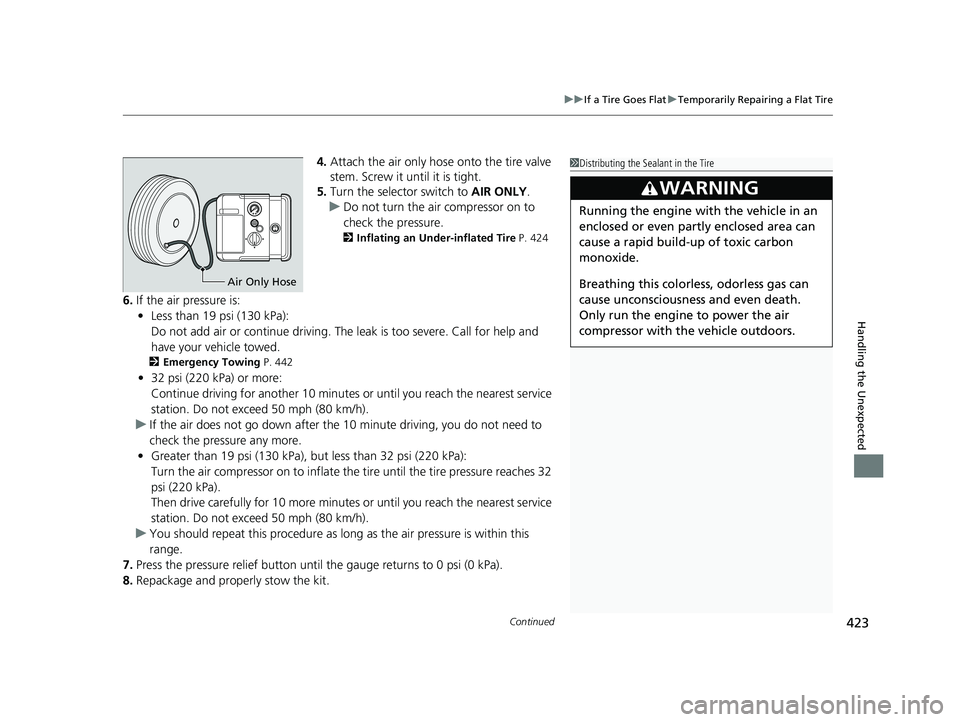
Continued423
uuIf a Tire Goes Flat uTemporarily Repairing a Flat Tire
Handling the Unexpected
4. Attach the air only hose onto the tire valve
stem. Screw it until it is tight.
5. Turn the selector switch to AIR ONLY.
u Do not turn the air compressor on to
check the pressure.
2 Inflating an Under-inflated Tire P. 424
6.If the air pressure is:
• Less than 19 psi (130 kPa):
Do not add air or continue driving. Th e leak is too severe. Call for help and
have your vehicle towed.
2 Emergency Towing P. 442
•32 psi (220 kPa) or more:
Continue driving for another 10 minutes or until you reach the nearest service
station. Do not exceed 50 mph (80 km/h).
u If the air does not go down after the 10 minute driving, you do not need to
check the pressure any more.
• Greater than 19 psi (130 kPa), but less than 32 psi (220 kPa):
Turn the air compressor on to inflate the tire until the tire pressure reaches 32
psi (220 kPa).
Then drive carefully for 10 more minutes or until you reach the nearest service
station. Do not exceed 50 mph (80 km/h).
u You should repeat this procedure as long as the air pressure is within this
range.
7. Press the pressure relief button until the gauge returns to 0 psi (0 kPa).
8. Repackage and properly stow the kit.
1Distributing the Sealant in the Tire
3WARNING
Running the engine with the vehicle in an
enclosed or even partly enclosed area can
cause a rapid build-up of toxic carbon
monoxide.
Breathing this colorless, odorless gas can
cause unconsciousness and even death.
Only run the engine to power the air
compressor with th e vehicle outdoors.
Air Only Hose
14 CIVIC 4D_SI-31TR36210.book 423 ページ 2014年1月30日 木曜日 午後12時18分